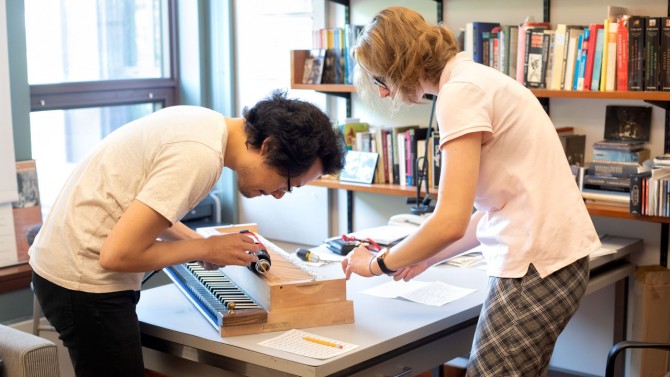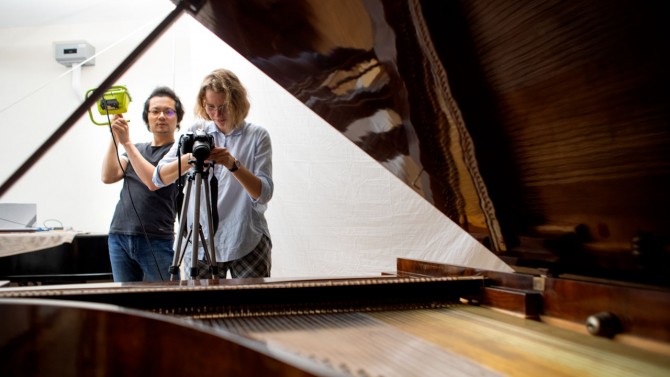When Elizaveta Zabelina '24 works on the replica of a ca. 1800 Johann Schantz piano that's part of the instrument collection at the Cornell Center for Historical Keyboards, she can't help feeling a bit philosophical.
"Because of the distinction of materials and work which was one of a kind in historical instruments, each instrument has its own spirit and character and tells us something new," said Zabelina, who is spending the summer helping to photograph and regulate the 17 historical pianos, harpsichords and clavichords in the collection for an expanded website to be hosted by the College of Arts and Sciences.
Mike Lee, Ph.D. '15 and Elizaveta Zabelina '24 regulate a piano modeled after that of Gottfried Silbermann (1749) by Paul McNulty.
"Both the act of performing and doing technical work inside the mechanism involve a developing relationship between the human and the instrument," Zabelina said. "I'm observing and participating in the relationship between material and immaterial."
Zabelina's project demonstrates how instruments, performance and research intersect at the Cornell Center for Historical Keyboards. Closely allied with the Cornell-based Westfield Center for Historical Keyboard Studies, the leading international organization for historical keyboard studies, the center brings together scholars and musicians from across the globe for its programs on the long history of keyboard music and instruments, technologies, repertoires and aesthetics - from the baroque organ to the player piano to the Moog synthesizer.
"I think it has become increasingly apparent to modern performers that one cannot reach a holistic understanding of music from past centuries without engaging with the diversity of instruments that contributed to their creation," said Mike Lee, Ph.D. '15, artist/scholar-in-residence with the Department of Music, who is leading the project.
These older pianos, which are so diverse in terms of materials, size and mechanics, create the opportunity for so many varied experiences of touch and sound based on the piano's designer and builder, the music's composer and the pianist, among other factors.
Lee and Zabelina regulate a piano modeled after Johann Schantz (ca. 1800) by Thomas and Barbara Wolf.
And the wonderful thing about Cornell's collection, Lee said, is that it's a working collection that is available to all students and faculty for performance and exploration from any intellectual angle. Students take lessons on the keyboards, which live at 726 University Ave. and in Lincoln and Barnes halls; they're also frequently featured by faculty and guest artists and can be moved for concerts.
Lee hopes they become even more widely used, offering open hours when the public could come and experience them and opportunities for musicians from outside Cornell to perform and conduct research.
Instruments in Cornell's collection encompass both originals and replicas, and are not limited to pianos. Highlights include the Baroque organ in Anabel Taylor Chapel, modeled after the Charlottenburg organ built by Arp Schnitger in Berlin in the early 18th century; original Graf, Broadwood and Pleyel pianos; early 20th-century Steinway, Blüthner, Bechstein and Mason & Hamlin pianos; and extending to the Moog synthesizer. The collection is also the permanent home of the personal fortepianos of music professor emeritus Malcolm Bilson.
This past year's series of performances, conversations and talks, "Beethoven Off the Beaten Track" can be visited here.
Zabelina, who is an international student from Russia, relates her work on the pianos to her various interests. As with many of her classes, Zabelina said, working with the collection has helped her to understand the interplay between so many disciplines of both the arts and the sciences. Although she has yet to declare a major, she's considering physics and philosophy, but also wants to continue her piano lessons with Lee.
Zabelina and Lee photograph a piano by Joseph Simon (1835) as part of their efforts to document the collection of the Cornell Center for Historical Keyboards.
"I'm inclined to think of causal relations," Zabelina said, adding that the keyboard work leads her to explore the physics of harmonic series, mathematical underpinnings of modern tuning and how mechanisms materially influence sound. Zabelina's work is supported by a Summer Experience Grant from A&S, which helps pay living and travel expenses for students who have unpaid or minimally paid career experiences.
Annette Richards, the Given Foundation Professor in the Humanities, university organist and executive director of the Westfield Center, is thrilled to have Zabelina on board this summer.
"Historical keyboard instruments are objects of great beauty and extraordinary technological sophistication. They embody the meeting of art and science, and it is fantastic to have Liza here this summer to help us explore those intersections," she said. "With the intellectual discipline and curiosity of the physicist, alongside the creative eye of the photographer and the sensitive ear of the musician, Liza's work here is already showing what hands-on exploration, artistic imagination and rigorous intellectual inquiry can achieve together."
Zabelina's work will eventually be available on a new website for the historical keyboards collection. To see what information is available now, visit this site.
Kathy Hovis is a writer for the College of Arts and Sciences.









